1943 GC: Loki (Allies) GloriousRuse (Axis)
Moderator: MOD_WarintheWest
RE: T78 - Last exit from Lombardy?
I've covered some of this in my next post but this triggers a few more observations.
GR has made more creative use of the late game LW than I have seen anyone else do. With the EF box on, I tend to send it east (but then I usually botch the force allocation to the East and need everything to repair it). Conventional wisdom has been that the loss of experienced replacements means its game over - he maybe being very ruthless at culling formations to recycle the experienced pilots but I am not hitting large numbers of low experience units.
I think he maybe stayed 2 turns too long defending the French landings. As I built up, I became more willing to risk my 50MP armour divisions on deeper salients - early on I had the capacity but couldn't be sure I could reach anything that got cut off. That is also prime killing zone for the allied airpower - but this is a fine judgement as the VP from Paris are worth a lot.
The Maas-Moselle operation is really a case of overloading the Germans. I think he's defended this phase well but in the end I have the capacity to go north, south or direct and make each a real threat. I can also almost always take a hex I want (even if I need to attack more than once). Now I'm not going to reach Berlin by taking a hex a turn, but the point is that any defensive line is finite.
He's been unlucky with the weather - we've had one turn of heavy rain/heavy mud, and are now in a sequence of clear skies. If he's really unlucky, it'll be two turns of blizzards as I reach the Rhine then I get to drive over it on the ice [;)]
GR has made more creative use of the late game LW than I have seen anyone else do. With the EF box on, I tend to send it east (but then I usually botch the force allocation to the East and need everything to repair it). Conventional wisdom has been that the loss of experienced replacements means its game over - he maybe being very ruthless at culling formations to recycle the experienced pilots but I am not hitting large numbers of low experience units.
I think he maybe stayed 2 turns too long defending the French landings. As I built up, I became more willing to risk my 50MP armour divisions on deeper salients - early on I had the capacity but couldn't be sure I could reach anything that got cut off. That is also prime killing zone for the allied airpower - but this is a fine judgement as the VP from Paris are worth a lot.
The Maas-Moselle operation is really a case of overloading the Germans. I think he's defended this phase well but in the end I have the capacity to go north, south or direct and make each a real threat. I can also almost always take a hex I want (even if I need to attack more than once). Now I'm not going to reach Berlin by taking a hex a turn, but the point is that any defensive line is finite.
He's been unlucky with the weather - we've had one turn of heavy rain/heavy mud, and are now in a sequence of clear skies. If he's really unlucky, it'll be two turns of blizzards as I reach the Rhine then I get to drive over it on the ice [;)]
T79 - I need a good tank garage
T79 – 30 December 1944
So we say good bye to 1944.
Next turn the divisors for my share of the VP drops by a 1/3, so this maybe the last +ve view for a while. Equally the German NM takes a turn for the worse and, assuming I take some German cities, I start to stack up city and bombing VP for the same hex.
At a guess this is heading for the boundary between Draw/Allied Minor which given our relative experience levels at the start of the game is very much to GR's credit. Since my brute force stunt at Rome he's done a good job controlling my expansion and making me dread the inevitable consequences of a naval invasion.

Last turn's massive A2A action over the Rhineland meant a lot of my fighters had to rest, still repeated a large commitment to FB-F and again a lot of action.
As in previous turns, the strategic bombing is now focussed on keeping the v-weapons under control.
Italy, Turin liberated, abandon attempt to seal off the exit from Lombardy to Alto-Adige and pull my remaining armour back to refit. 5 Army carries on with its limited offensive between Verona and Rovigo.
Abandoned offensive at Belfort and handed that sector over to 15A. Small gains towards Strasbourg but it will be a couple of turns before this part of the front can attack again. Also sending some reinforcements to that sector and that will consume rail capacity over the next 2 turns.
Before describing the main action, an indication of why its damaged, not missing, elements that are hurting me. This Canadian division was badly beaten up a few turns ago, its effectively in reserve and has all its elements. Just that around 25% of its tanks are still damaged from the earlier fighting.

Weather is due to hold for the next week, so opted for only limited actions after last week. Running low on MP so any gains would be purely linear.
This suits the operations in the Netherlands so 1 Canadian carries on its steady progress reaching Den Haag and Rotterdam. I opted to rout the German units out of Maastricht as I want the freedom of movement but generated a small pocket in the Ardennes.
All of Belgium is now liberated.
3 Army does a bit of redeployment as it needs to clear its flanks.
Changed the soft factor to show ammunition, pleasing to see so many German units on red – also explains a lot of their CV crashes once they are forced to fight.
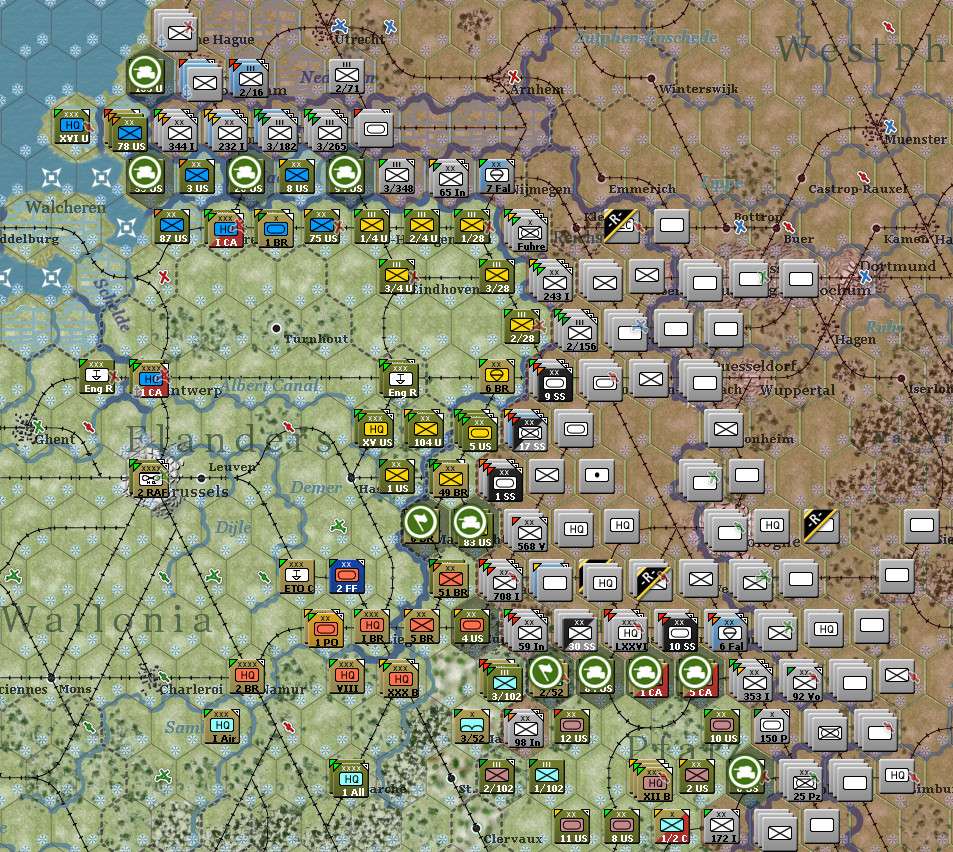
So given a quiet turn and the end of 1944, lets do some overviews.
OOB, as mentioned above, the big drag on my effective combat power is now damaged tanks. I have 6,500 of these.
7 Army is now disengaging from Italy and is planned to move to France, it'll clear out the last of the border units as it goes. Some by rail, some by sea.

Overall view of the front.
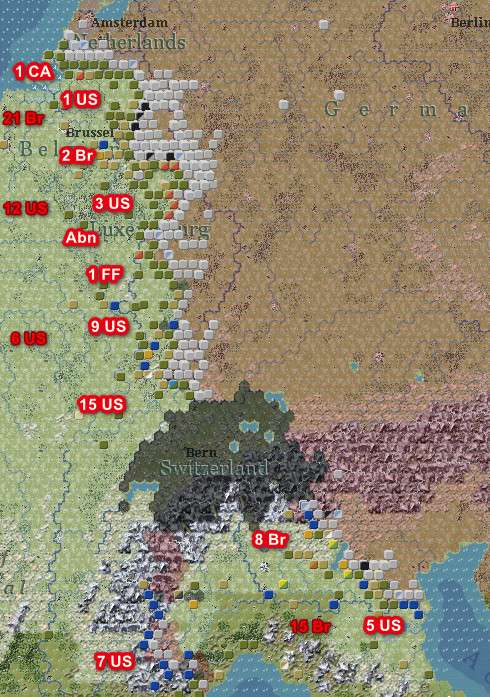
Air OOB. Malta and 15 AAF are now in France. Malta Air is supporting 1 FF and 9A. 15 AAF is in France mainly as its easier to bomb S Germany without having to cross the Alps in winter. In practice, the Strategic air war is effectively over (except for controlling the v-weapon problem).
Only Tactical Air, Coastal Air and XII Troop Carrier Commands are still in Italy.

Rail net in France, southern armies are getting some supply off Bordeaux and the 2 rail lines that run up the Rhone. My auto-repair assets have done a good job at filling in all the gaps in the northern portion.
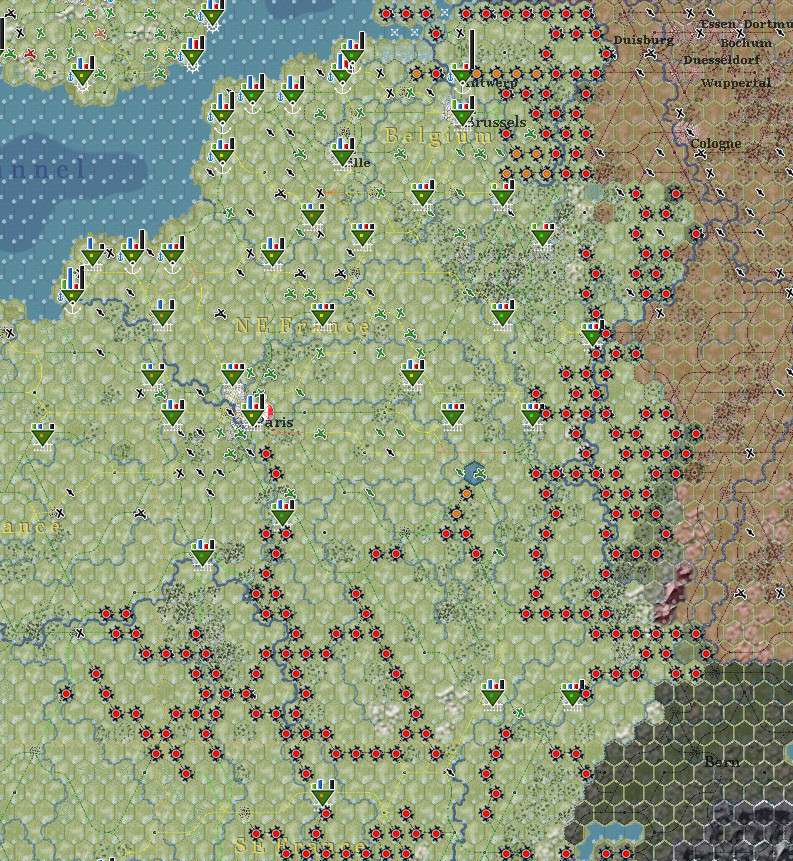
Operationallly, clearly the next goal is to reach and force the Rhine. At some stage the weather is going to turn against me.
The Rhineland itself is doomed, I have my 3 most powerful armies and most of my airpower all available.
Also over the next few turns, a lot of German armour is going to be sent to play with the Red Army.

The campaign in the Netherlands is worth keeping going. Its a source of VP and potentially a lot more shipping capacity (and trains).
In turn that will really help once/if I'm over the Rhine.
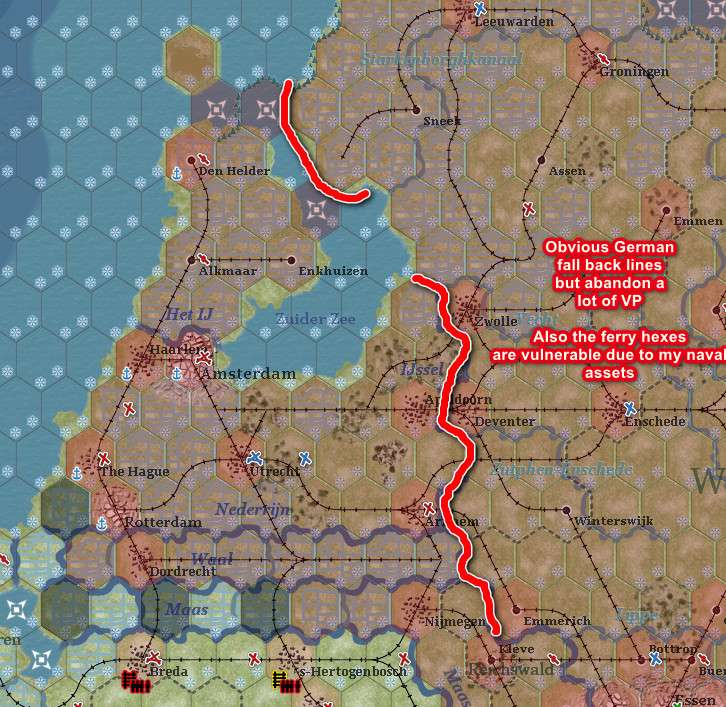
It will take a few turns to redeploy but a significant effort towards Mainz may also be a useful secondary operation. Trier in the short term is worth a serious effort as it will ease resupply for 3 Army.

Italy now is effectively a cost-benefit issue. I need to leave some units here (not least I can't supply them in the NW) so can make steady gains. There are quite a few VP still to acquire. But if it becomes costly I can go over to the defensive.

Losses, high for a turn when I thought I didn't do much. Again German armour losses are mostly TD/AG types. My outright tank losses are not my biggest concern – as above its getting the damaged ones to repair.

Destroyed list. Nothing important for the Germans, am scrapping a few units to push the manpower/elements into more important formations. Some British tank brigades are next to be removed.
My admin pt collection is improving as I'm making very little use of motorisation (I have so much armour available) so that means I can both scrap some things and still maintain depot creation/repair.

So since we are on the topic. Here's an American tank being recovered ... I need them all back in their units.

So we say good bye to 1944.
Next turn the divisors for my share of the VP drops by a 1/3, so this maybe the last +ve view for a while. Equally the German NM takes a turn for the worse and, assuming I take some German cities, I start to stack up city and bombing VP for the same hex.
At a guess this is heading for the boundary between Draw/Allied Minor which given our relative experience levels at the start of the game is very much to GR's credit. Since my brute force stunt at Rome he's done a good job controlling my expansion and making me dread the inevitable consequences of a naval invasion.

Last turn's massive A2A action over the Rhineland meant a lot of my fighters had to rest, still repeated a large commitment to FB-F and again a lot of action.
As in previous turns, the strategic bombing is now focussed on keeping the v-weapons under control.
Italy, Turin liberated, abandon attempt to seal off the exit from Lombardy to Alto-Adige and pull my remaining armour back to refit. 5 Army carries on with its limited offensive between Verona and Rovigo.
Abandoned offensive at Belfort and handed that sector over to 15A. Small gains towards Strasbourg but it will be a couple of turns before this part of the front can attack again. Also sending some reinforcements to that sector and that will consume rail capacity over the next 2 turns.
Before describing the main action, an indication of why its damaged, not missing, elements that are hurting me. This Canadian division was badly beaten up a few turns ago, its effectively in reserve and has all its elements. Just that around 25% of its tanks are still damaged from the earlier fighting.

Weather is due to hold for the next week, so opted for only limited actions after last week. Running low on MP so any gains would be purely linear.
This suits the operations in the Netherlands so 1 Canadian carries on its steady progress reaching Den Haag and Rotterdam. I opted to rout the German units out of Maastricht as I want the freedom of movement but generated a small pocket in the Ardennes.
All of Belgium is now liberated.
3 Army does a bit of redeployment as it needs to clear its flanks.
Changed the soft factor to show ammunition, pleasing to see so many German units on red – also explains a lot of their CV crashes once they are forced to fight.

So given a quiet turn and the end of 1944, lets do some overviews.
OOB, as mentioned above, the big drag on my effective combat power is now damaged tanks. I have 6,500 of these.
7 Army is now disengaging from Italy and is planned to move to France, it'll clear out the last of the border units as it goes. Some by rail, some by sea.

Overall view of the front.

Air OOB. Malta and 15 AAF are now in France. Malta Air is supporting 1 FF and 9A. 15 AAF is in France mainly as its easier to bomb S Germany without having to cross the Alps in winter. In practice, the Strategic air war is effectively over (except for controlling the v-weapon problem).
Only Tactical Air, Coastal Air and XII Troop Carrier Commands are still in Italy.

Rail net in France, southern armies are getting some supply off Bordeaux and the 2 rail lines that run up the Rhone. My auto-repair assets have done a good job at filling in all the gaps in the northern portion.

Operationallly, clearly the next goal is to reach and force the Rhine. At some stage the weather is going to turn against me.
The Rhineland itself is doomed, I have my 3 most powerful armies and most of my airpower all available.
Also over the next few turns, a lot of German armour is going to be sent to play with the Red Army.

The campaign in the Netherlands is worth keeping going. Its a source of VP and potentially a lot more shipping capacity (and trains).
In turn that will really help once/if I'm over the Rhine.

It will take a few turns to redeploy but a significant effort towards Mainz may also be a useful secondary operation. Trier in the short term is worth a serious effort as it will ease resupply for 3 Army.

Italy now is effectively a cost-benefit issue. I need to leave some units here (not least I can't supply them in the NW) so can make steady gains. There are quite a few VP still to acquire. But if it becomes costly I can go over to the defensive.

Losses, high for a turn when I thought I didn't do much. Again German armour losses are mostly TD/AG types. My outright tank losses are not my biggest concern – as above its getting the damaged ones to repair.

Destroyed list. Nothing important for the Germans, am scrapping a few units to push the manpower/elements into more important formations. Some British tank brigades are next to be removed.
My admin pt collection is improving as I'm making very little use of motorisation (I have so much armour available) so that means I can both scrap some things and still maintain depot creation/repair.

So since we are on the topic. Here's an American tank being recovered ... I need them all back in their units.

RE: T79 - I need a good tank garage
Maastricht is cut off but not properly surrounded but its now clear terrain all the way to the Rhine (apart from Aachen).
which relates to my post in war room about the missing Roer River!
RE: T79 - I need a good tank garage
maybe, it often comes down to judgements if you added every river then virtually every hex side would be a minor river so you need some smoothing of effects?
-
GloriousRuse
- Posts: 923
- Joined: Sat Oct 26, 2013 12:51 am
RE: T79 - I need a good tank garage
I think the Roer, as a river, was mostly an issue for the two weeks after the Germans blew the dam and flooded it. Apparently for those weeks it became a major obstacle. German generals wanted to use the time to withdraw behind the Rhine un-pressured, but Hitler insisted they fight forward behind the new obstacle. It went back to being rather small and the Germans behind the now negligible obstacle got butchered.
T80 - Aachen joins the Allies
T80 – 6 January 1945
Bit of a German offensive in Lorraine with related strikes against my depots on that sector.
For once my auto-intercepts actually worked fairly well and the Chalons raid killed some innocent French citizens. Raid on Verdun did real damage to the rail yard.

First exposure to the 1945 VP chart. Bombing, as such, is now pretty much useless as a source of VP but I don't want to lose too many to the v-weapons so need to keep that going. Other than that, its the predictable ratio of losses:cities.

Weather changes to snowfall so that degrades my airpower.
Italy, Rovigo taken, Armoured formations recovering from their trip around the Alpine foothills. Key rail links cleared in the Western Alps.
Lorraine sector, no real action, beat up an incautious Pzr brigade but its all about redeploying and a supply build up. Since there is clear terrain behind the front, its worth pushing my mobile MP up as much as I can.
2 British launched an overwhelming assault on Aachen – so that wins the city challenge.

As in GR's analysis above, there are two means to solve the supply constraints for 3 Army and one is from the north. My, not very Canadian, 1 Canadian army carries on clearing the rivers in the Netherlands, they've attracted the attentions of at least one Pzr division.

I'm not too sure where my losses are coming from on the main display. I've lost the image, but initially this was showing 18,000 axis and 16,000 allied losses for the turn – same point as I noted in the T79 report.
When I break it down across end 79, start 80, end 80, the axis losses look ok but the allied losses are far less.

That closer analysis is supported by a list of all the ground attacks by both sides that turn.

Supply situation. Predictable gaps (9, 15, 1FF) not helped by a number of strategic redeployments.
Best I can guess is they will be ready in 3-4 turns.
Better is that 1 US and 2 Br are now clear of the Maas (which at ice 3/4 is a real drag on MP) and well placed to attack towards the Rhine.

Since I've taken it much later than history, here's an image of the Battle for Aachen:

Bit of a German offensive in Lorraine with related strikes against my depots on that sector.
For once my auto-intercepts actually worked fairly well and the Chalons raid killed some innocent French citizens. Raid on Verdun did real damage to the rail yard.

First exposure to the 1945 VP chart. Bombing, as such, is now pretty much useless as a source of VP but I don't want to lose too many to the v-weapons so need to keep that going. Other than that, its the predictable ratio of losses:cities.

Weather changes to snowfall so that degrades my airpower.
Italy, Rovigo taken, Armoured formations recovering from their trip around the Alpine foothills. Key rail links cleared in the Western Alps.
Lorraine sector, no real action, beat up an incautious Pzr brigade but its all about redeploying and a supply build up. Since there is clear terrain behind the front, its worth pushing my mobile MP up as much as I can.
2 British launched an overwhelming assault on Aachen – so that wins the city challenge.

As in GR's analysis above, there are two means to solve the supply constraints for 3 Army and one is from the north. My, not very Canadian, 1 Canadian army carries on clearing the rivers in the Netherlands, they've attracted the attentions of at least one Pzr division.

I'm not too sure where my losses are coming from on the main display. I've lost the image, but initially this was showing 18,000 axis and 16,000 allied losses for the turn – same point as I noted in the T79 report.
When I break it down across end 79, start 80, end 80, the axis losses look ok but the allied losses are far less.

That closer analysis is supported by a list of all the ground attacks by both sides that turn.

Supply situation. Predictable gaps (9, 15, 1FF) not helped by a number of strategic redeployments.
Best I can guess is they will be ready in 3-4 turns.
Better is that 1 US and 2 Br are now clear of the Maas (which at ice 3/4 is a real drag on MP) and well placed to attack towards the Rhine.

Since I've taken it much later than history, here's an image of the Battle for Aachen:

RE: T80 - Aachen joins the Allies
I've been reading these AARs for awhile and I have to say that GR is getting much more out of the Luftwaffe than I think I've seen anybody else do. [&o][&o]
John Barr
RE: T80 - Aachen joins the Allies
ORIGINAL: John B.
I've been reading these AARs for awhile and I have to say that GR is getting much more out of the Luftwaffe than I think I've seen anybody else do. [&o][&o]
yep, I'd agree with that. I think in part with the EF box on, the LBs are an easy way to get force allocation over there. But more importantly he's picked a few things that can be effective and stuck to it - ok it has bad turns like the next one ([;)]) but its another drag on me getting my supply system up and running.
edit - its another of those instances where if I'm responding, I'm not doing what I want to do - in this case none of my FB-F are acting as FB*, so that is around 300 FB per turn missing
T81 - Driving in the Veneto
T81 – 13 January 1945
Further German attacks in Lorraine, but this time it seems that my defensive air deployment paid off.

VP chart at +0 (or -0 if you see things that way) [1]. Dominant weather snowfall/snow and it looks like more of this next week. [2]
Air directives, still looking for any functioning v-weapons but basically the entire German front line in the Rhineland was bombed. Even with the impact of snowstorms, 400 level bombers do a fair bit of damage to a stack.
Rare view of the Italian front. 5 Army broke the German front with hasty attacks and then my fresh (50 MP) armoured divisions were able to exploit. Between that and a well timed partisan attack, I've cut the rail lines from Verona-Vicenza going east.
Still some skirmishes in the Maritime Alps as I clear the last blocks off the rails I want to have clear – goal now is to encourage the Italian supply production to go up into France..

Scattered fighting across the southern sector of the French-German border. 15 A makes some gains towards Colmar and elements of 9 Army press up to Trier. Elsewhere probing for the German defensive line and letting a lot of formations rest.
I have a dense network of depots now but all behind the Moselle. So they help but the extra MP due to snow and major rivers means I am still losing a lot of trucks to the resupply effort.
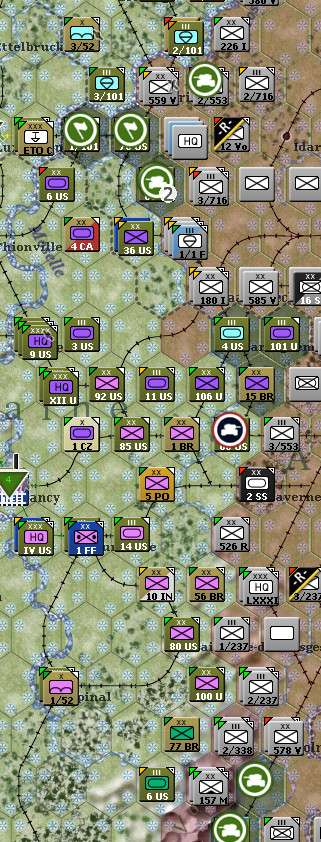
1 US and 2 Br faced the same problem, relatively high CV, relatively low MP and the additional costs of moving in the snow. Fortunately, the Germans opted to hold the front near to my formations. The result was a grim battering of the Pzrs, and effectively wrecking around 8 infantry divisions – these all ended up routing, while others took heavy losses.
The routed list included 1 SS Pzr (1st) division, 3 infantry divisions, 2 VG divisions, 5 infantry regiments, 1 SS Infantry division. The VG are very vulnerable as often have low experience and if their ToE drops then quite hard to recover.
I basically lack the MP to generate pockets and since the Pzrs have a date with the Red Army, these disruptions may leave this sector lacking much depth. If the next phase pulls the remaining German elite units (Pzrs/FJ) into the front line then they are reaching a critical point.

I Canadian takes Dordrecht, one more river line and it is into N Holland. First of my ex-Italian divisions arrives, they will get at least one real Canadian division over the next few weeks.
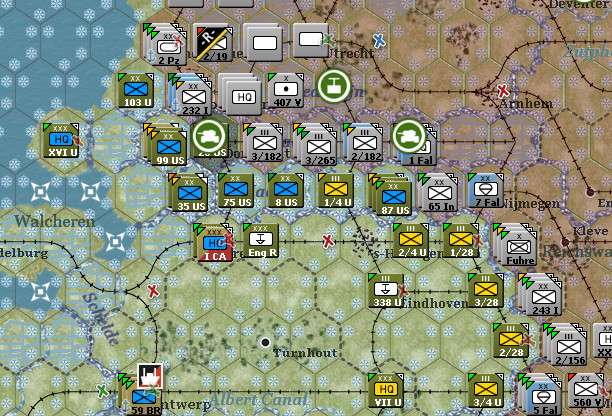
For a turn with no pockets that was relatively one sided. The regular German infantry formations become more and more vulnerable.
Some of my losses are due to naval moves from the Med. Don't want to overload the Rhone rail network too much. At least when they arrive in the UK then can stock up on any missing elements.

Disbanding a few more units to free up manpower/elements. No real point to having units <50% TOE on refit when I am short overall (or they are behind a sector with limited freight). This has helped stabilise the situation for the British formations. Have set a lower ToE for the UK formations left in Italy.
That will both stop that sector claiming replacements and reduce the local supply usage.

Since it was some P-38s that culled the Axis air offensive in Lorraine, they get the picture of the week slot. For additional realism, it is even in the snow.

A short digression on the VP and freezing rules, I've pulled down from the main discussion as it may be of no interest or you may well know all this. However, it influences how I think about this phase as the Rhine battle is probably the last conventional linear action – after this its a matter of screens and increasingly separated sieges.
[1]
Starting to accumulate some secondary bombing VP for occupation of German hexes. So far 8 Manpower, 10 Industry and 8 Fuel factories. Since they are treated as 100% damaged that is worth (26*100)/1000 and then apply the 1945 divisor, so 2.6/18 – yep around .12 VP per turn (or in other words I need around 200 bombing points to gain 1 bombing VP per turn). To place this in context, the Ruhr collectively has around 300 such points.
Aachen itself adds another 1/18 as it is a city so pushes my German gains to around .18 VP per turn.
West of the Rhine, it probably all adds up to around 1 VP per turn. In effect, this doesn't really start to contribute till regions like the Ruhr have been occupied.
[2]
At the moment most hexes in N Europe are at snow level 6 and the rivers at ice 4.
Very roughly, south of Bonn the levels are 5 and 3 respectively.
The problem is that my supply lines pay the motorised cost and a minor river with 4 ice costs an extra 3 MP and a major river +6. Major rivers get worse at ice 5-7, costing +8 (I'm ignoring the ZoC effect here).
In a way it suits me to fight in the Rhineland, those costs make an attack over the Rhine very hard – not just the cost of mounting the assault but of putting exploitation units across, almost inevitably through ZoC.
Another snow turn will push the values in the north to 7/5. If so minor rivers effectively have no impact.
The key shift will be a blizzard, given the major rivers will be at +6 in a couple of turns, a single blizzard pushes them to +8 and frozen. That removes almost all the combat penalty. Now its feasible to get a winter with no blizzard but we are at the stage where one would be very welcome. Of course that'll swap the ground to heavy snow, but with good roads that is no worse than the current conditions.
All this adds to the fun of decision making in this game – where to fight, how fast to try and go, will you get caught up on a partially frozen major river, all feed into both sides' decision frame for the November – February period.
Further German attacks in Lorraine, but this time it seems that my defensive air deployment paid off.

VP chart at +0 (or -0 if you see things that way) [1]. Dominant weather snowfall/snow and it looks like more of this next week. [2]
Air directives, still looking for any functioning v-weapons but basically the entire German front line in the Rhineland was bombed. Even with the impact of snowstorms, 400 level bombers do a fair bit of damage to a stack.
Rare view of the Italian front. 5 Army broke the German front with hasty attacks and then my fresh (50 MP) armoured divisions were able to exploit. Between that and a well timed partisan attack, I've cut the rail lines from Verona-Vicenza going east.
Still some skirmishes in the Maritime Alps as I clear the last blocks off the rails I want to have clear – goal now is to encourage the Italian supply production to go up into France..

Scattered fighting across the southern sector of the French-German border. 15 A makes some gains towards Colmar and elements of 9 Army press up to Trier. Elsewhere probing for the German defensive line and letting a lot of formations rest.
I have a dense network of depots now but all behind the Moselle. So they help but the extra MP due to snow and major rivers means I am still losing a lot of trucks to the resupply effort.

1 US and 2 Br faced the same problem, relatively high CV, relatively low MP and the additional costs of moving in the snow. Fortunately, the Germans opted to hold the front near to my formations. The result was a grim battering of the Pzrs, and effectively wrecking around 8 infantry divisions – these all ended up routing, while others took heavy losses.
The routed list included 1 SS Pzr (1st) division, 3 infantry divisions, 2 VG divisions, 5 infantry regiments, 1 SS Infantry division. The VG are very vulnerable as often have low experience and if their ToE drops then quite hard to recover.
I basically lack the MP to generate pockets and since the Pzrs have a date with the Red Army, these disruptions may leave this sector lacking much depth. If the next phase pulls the remaining German elite units (Pzrs/FJ) into the front line then they are reaching a critical point.

I Canadian takes Dordrecht, one more river line and it is into N Holland. First of my ex-Italian divisions arrives, they will get at least one real Canadian division over the next few weeks.

For a turn with no pockets that was relatively one sided. The regular German infantry formations become more and more vulnerable.
Some of my losses are due to naval moves from the Med. Don't want to overload the Rhone rail network too much. At least when they arrive in the UK then can stock up on any missing elements.

Disbanding a few more units to free up manpower/elements. No real point to having units <50% TOE on refit when I am short overall (or they are behind a sector with limited freight). This has helped stabilise the situation for the British formations. Have set a lower ToE for the UK formations left in Italy.
That will both stop that sector claiming replacements and reduce the local supply usage.

Since it was some P-38s that culled the Axis air offensive in Lorraine, they get the picture of the week slot. For additional realism, it is even in the snow.

A short digression on the VP and freezing rules, I've pulled down from the main discussion as it may be of no interest or you may well know all this. However, it influences how I think about this phase as the Rhine battle is probably the last conventional linear action – after this its a matter of screens and increasingly separated sieges.
[1]
Starting to accumulate some secondary bombing VP for occupation of German hexes. So far 8 Manpower, 10 Industry and 8 Fuel factories. Since they are treated as 100% damaged that is worth (26*100)/1000 and then apply the 1945 divisor, so 2.6/18 – yep around .12 VP per turn (or in other words I need around 200 bombing points to gain 1 bombing VP per turn). To place this in context, the Ruhr collectively has around 300 such points.
Aachen itself adds another 1/18 as it is a city so pushes my German gains to around .18 VP per turn.
West of the Rhine, it probably all adds up to around 1 VP per turn. In effect, this doesn't really start to contribute till regions like the Ruhr have been occupied.
[2]
At the moment most hexes in N Europe are at snow level 6 and the rivers at ice 4.
Very roughly, south of Bonn the levels are 5 and 3 respectively.
The problem is that my supply lines pay the motorised cost and a minor river with 4 ice costs an extra 3 MP and a major river +6. Major rivers get worse at ice 5-7, costing +8 (I'm ignoring the ZoC effect here).
In a way it suits me to fight in the Rhineland, those costs make an attack over the Rhine very hard – not just the cost of mounting the assault but of putting exploitation units across, almost inevitably through ZoC.
Another snow turn will push the values in the north to 7/5. If so minor rivers effectively have no impact.
The key shift will be a blizzard, given the major rivers will be at +6 in a couple of turns, a single blizzard pushes them to +8 and frozen. That removes almost all the combat penalty. Now its feasible to get a winter with no blizzard but we are at the stage where one would be very welcome. Of course that'll swap the ground to heavy snow, but with good roads that is no worse than the current conditions.
All this adds to the fun of decision making in this game – where to fight, how fast to try and go, will you get caught up on a partially frozen major river, all feed into both sides' decision frame for the November – February period.
T82 - Bonn will make a nice capital ...
T82 – 20 January 1945
Weather is as predicted snowfall/snow, same the next week. So the minor rivers are now mostly frozen over.
VP down to -6 (shipping losses)
Due to the snow, doing less interdiction apart from over particular formations or hexes. So most airpower is on either unit missions or GS. Some strategic missions.
So starting in Italy. Veneto offensive continues, looks like the Germans are trying a hedgehog style defense which could delay me as I am obviously short of units here now. Tried to seize Treviso with a paratroop drop but they decided to capture the terrain north of the town instead.

Start the main offensive in Lorraire. Saarbruecken holds off the initial attack but my rested tanks manage a salient behind the city.

Rhineland was a bit frustrating as I dealt with the screen of weak units holding the front. Main attack was by most of 3 Army to clear Bonn. Let as much of 2 Br and 1 US rest as I could.

I Canadian struggling for MP with the ice levels (5) and major rivers. So take what I can [1] rather than what I want but now placed to force the Neijder-Rijn next turn.

Ground losses seem unfeasibly high, given I only lost 500 men in the Bonn attack (which was the only major offensive).

This time I remembered to take the at start table, so the reported number is about three times as high as actually happened -

So there are two errors there. First the inflation of Allied losses and second that all recorded losses are killed in action. Also my real tank losses were around 230 not the almost 1,000 shown in the end turn table.
The other thing that worries me is which figure is being fed into the VP calculation.
[1]
Another aside, this time on the impact of rivers. Again I've dropped this down to the foot of the post so you can ignore if you already understand all this – but again its very relevant to what is going to happen soon (I hope).
A lot of players read the manual and mis-read the comment about the CV reductions (half for minor river, 2/3 for major) and assume that rivers are a better defensive line than they appear.
What happens in a river action is the attacker's close combat elements are tested for disruption (armour suffers very badly for major rivers) – as ever disrupted elements are set to one side.
The combat then works out as normal with both sides picking up destroyed, damaged and disrupted elements. Once all this is done, the cv ratio is recalculated and it is at this stage the attacker has the arbitrary reduction (in the same way that for a naval beachhead the defender gets their bonus). Of course any attackers not forcing the river escape this malus.
So going back a few turns, we can use my attack over the Maas as a practical example. The Allied losses include a lot of disruptions, especially in the attacking infantry for the relatively low losses. The tanks were involved at range so escaped the crossing penalty – also the Germans lacked much AT capacity.

The main thing is the combat then proceeds as normal, in particular fortifications can be degraded by artillery and engineers and that can radically reduce the defensive cv – potentially by far more than the cross-river malus.
So the German cv goes from 198 to 84 (normal loss calculation mostly), I'd guess the fort went from 3 to 2 (which hits their final cv), mine from 524 to 219.

Key issue here is rivers are only a reliable defense if the units behind them are in broken (or urban) terrain (ie can't be reduced by artillery) and are good quality. As ever for the attacker the advice is to look at the attack cv not the shown defensive cv. The attack cv gives you a good hint as to the quality of what you face.
This is the situation at the start of that turn, so they had a notional attack value of 5 and at least one unit in the stack had an ammunition shortage (which was going to get worse when they had to fire off AA).

In effect, a major river crossing is a set-piece, best done with lots of artillery and airpower (and reserves to ensure you can occupy your gains), its not an impenetrable barrier.
as an edit to this, I read a comment by Joel somewhere (can't find it back) that a good rough and ready estimate is that a minor river will take away about 10% of the pre-attack cv. If so, I'd guess a major rivers fall around 30-40%.
Weather is as predicted snowfall/snow, same the next week. So the minor rivers are now mostly frozen over.
VP down to -6 (shipping losses)
Due to the snow, doing less interdiction apart from over particular formations or hexes. So most airpower is on either unit missions or GS. Some strategic missions.
So starting in Italy. Veneto offensive continues, looks like the Germans are trying a hedgehog style defense which could delay me as I am obviously short of units here now. Tried to seize Treviso with a paratroop drop but they decided to capture the terrain north of the town instead.

Start the main offensive in Lorraire. Saarbruecken holds off the initial attack but my rested tanks manage a salient behind the city.

Rhineland was a bit frustrating as I dealt with the screen of weak units holding the front. Main attack was by most of 3 Army to clear Bonn. Let as much of 2 Br and 1 US rest as I could.

I Canadian struggling for MP with the ice levels (5) and major rivers. So take what I can [1] rather than what I want but now placed to force the Neijder-Rijn next turn.

Ground losses seem unfeasibly high, given I only lost 500 men in the Bonn attack (which was the only major offensive).

This time I remembered to take the at start table, so the reported number is about three times as high as actually happened -

So there are two errors there. First the inflation of Allied losses and second that all recorded losses are killed in action. Also my real tank losses were around 230 not the almost 1,000 shown in the end turn table.
The other thing that worries me is which figure is being fed into the VP calculation.
[1]
Another aside, this time on the impact of rivers. Again I've dropped this down to the foot of the post so you can ignore if you already understand all this – but again its very relevant to what is going to happen soon (I hope).
A lot of players read the manual and mis-read the comment about the CV reductions (half for minor river, 2/3 for major) and assume that rivers are a better defensive line than they appear.
What happens in a river action is the attacker's close combat elements are tested for disruption (armour suffers very badly for major rivers) – as ever disrupted elements are set to one side.
The combat then works out as normal with both sides picking up destroyed, damaged and disrupted elements. Once all this is done, the cv ratio is recalculated and it is at this stage the attacker has the arbitrary reduction (in the same way that for a naval beachhead the defender gets their bonus). Of course any attackers not forcing the river escape this malus.
So going back a few turns, we can use my attack over the Maas as a practical example. The Allied losses include a lot of disruptions, especially in the attacking infantry for the relatively low losses. The tanks were involved at range so escaped the crossing penalty – also the Germans lacked much AT capacity.

The main thing is the combat then proceeds as normal, in particular fortifications can be degraded by artillery and engineers and that can radically reduce the defensive cv – potentially by far more than the cross-river malus.
So the German cv goes from 198 to 84 (normal loss calculation mostly), I'd guess the fort went from 3 to 2 (which hits their final cv), mine from 524 to 219.

Key issue here is rivers are only a reliable defense if the units behind them are in broken (or urban) terrain (ie can't be reduced by artillery) and are good quality. As ever for the attacker the advice is to look at the attack cv not the shown defensive cv. The attack cv gives you a good hint as to the quality of what you face.
This is the situation at the start of that turn, so they had a notional attack value of 5 and at least one unit in the stack had an ammunition shortage (which was going to get worse when they had to fire off AA).

In effect, a major river crossing is a set-piece, best done with lots of artillery and airpower (and reserves to ensure you can occupy your gains), its not an impenetrable barrier.
as an edit to this, I read a comment by Joel somewhere (can't find it back) that a good rough and ready estimate is that a minor river will take away about 10% of the pre-attack cv. If so, I'd guess a major rivers fall around 30-40%.
-
GloriousRuse
- Posts: 923
- Joined: Sat Oct 26, 2013 12:51 am
RE: T92 - Bonn will make a nice capital ...
I'm flattered on the LW. I don't think I did anything special, but here's what I can think of:
-The nightfighters were used as a live fire training course. I set them to normal and let their pools swell in low risk engagements with bomber command. That gave me a large pool of "good enough" pilots rather than a small pool of ace ones when the time came to cash them in.
-I decided in '44 I was only going to fight where I could mass hundreds of fighters. This lead to a few slaughterhouse turns, but also several turns where units could rest and very few pilots died. In return Loki got through on a lot of raids, but I tend to think he would have anyhow - sending thirty planes up against 500 doesn't work well, and Loki was sending massive raids for a while.
-I completely forgot to check my national reserves from D-Day to around September. My mind wasn't on the strat air. Whoops. Unexpected upside, quite a few formations hadn't been burned out.
-Bombers I gave normal pilot replacements after Rome. Good bomber, bad bomber, it's still bombs n target if you get it right and its still dead if you drive it in the wrong spot against the WA. So better to have enough to make some mistakes.
-And I nearly forgot the most important part: I plagiarized from Loki mercilessly. He is good at the fiddly bits and neatly defined a lot of what was possible. It wasn't so much being creative as stealing his tools and throwing them back the other way.
-The nightfighters were used as a live fire training course. I set them to normal and let their pools swell in low risk engagements with bomber command. That gave me a large pool of "good enough" pilots rather than a small pool of ace ones when the time came to cash them in.
-I decided in '44 I was only going to fight where I could mass hundreds of fighters. This lead to a few slaughterhouse turns, but also several turns where units could rest and very few pilots died. In return Loki got through on a lot of raids, but I tend to think he would have anyhow - sending thirty planes up against 500 doesn't work well, and Loki was sending massive raids for a while.
-I completely forgot to check my national reserves from D-Day to around September. My mind wasn't on the strat air. Whoops. Unexpected upside, quite a few formations hadn't been burned out.
-Bombers I gave normal pilot replacements after Rome. Good bomber, bad bomber, it's still bombs n target if you get it right and its still dead if you drive it in the wrong spot against the WA. So better to have enough to make some mistakes.
-And I nearly forgot the most important part: I plagiarized from Loki mercilessly. He is good at the fiddly bits and neatly defined a lot of what was possible. It wasn't so much being creative as stealing his tools and throwing them back the other way.
-
GloriousRuse
- Posts: 923
- Joined: Sat Oct 26, 2013 12:51 am
RE: T92 - Bonn will make a nice capital ...
Also, re: display bugs.
Not sure if this helps, but the hypothesis I’m holding is that the total is under-displaying because it’s only counting “battle” actions like attacks and air strikes.
The very high turn numbers make sense - front line attrition destroys between 0.25% to 0.7% of all elements in adjacent units each turn, and by now we have literally millions of men in adjacent units. The minimum “in contact” tax would be 2500 per million, before accounting for both of us sucking on supply, fatigue-damage conversions, two for one rebuilds, wear and tear, and all the other bits of the log phase.
Presumably this means that somehow the log phase losses aren’t being factored in to the displayed total
Not sure if this helps, but the hypothesis I’m holding is that the total is under-displaying because it’s only counting “battle” actions like attacks and air strikes.
The very high turn numbers make sense - front line attrition destroys between 0.25% to 0.7% of all elements in adjacent units each turn, and by now we have literally millions of men in adjacent units. The minimum “in contact” tax would be 2500 per million, before accounting for both of us sucking on supply, fatigue-damage conversions, two for one rebuilds, wear and tear, and all the other bits of the log phase.
Presumably this means that somehow the log phase losses aren’t being factored in to the displayed total
RE: T92 - Bonn will make a nice capital ...
ORIGINAL: GloriousRuse
Also, re: display bugs.
Not sure if this helps, but the hypothesis I’m holding is that the total is under-displaying because it’s only counting “battle” actions like attacks and air strikes.
The very high turn numbers make sense - front line attrition destroys between 0.25% to 0.7% of all elements in adjacent units each turn, and by now we have literally millions of men in adjacent units. The minimum “in contact” tax would be 2500 per million, before accounting for both of us sucking on supply, fatigue-damage conversions, two for one rebuilds, wear and tear, and all the other bits of the log phase.
Presumably this means that somehow the log phase losses aren’t being factored in to the displayed total
aye, having chacked back over a couple of turns, agree with this. The shown figure is correct for the turn - not for your complete turn. So that is why the axis figures are correct when I see them but mine are off (picking up losses from the half of my turn in the axis phase).
This has been raised before, in WiTE1/2 its not too important, losses have meaning as an overall metric but in WiTW its the link to the VP metric
T83 - The Chioggia disaster
T83 – 27 January 1945
VP at + (or -) 0, ok for these turns since its basically city VP vs Loss VP.
Weather remains snowfall/snow, may flip to cold/snow next week and that means I can actually hit things with my bombers. To prepare for this, rest a lot by raising the base morale for this criteria (from my usual 52 to 60). I also suspend the few interdiction style missions I was still doing.
Of course, it does reduce the chance the Rhine will actually freeze.
So lets do things in a sort of reverse order. I Canadian is only making slow progress, movement costs are so bad that a division with 12 MP can't make a prepared attack. That plus the local Pzr division made cutting in behind Rotterdam expensive. But I'll be able to build up and am across the last barrier.

Not much action for 2 Br or 3 US as they build up.
1 Army struck north, almost surrounding Moenchen-Gladbach and reaching Krefeld. Overall, I'm happy to try and orientate this army around the north of the Ruhr, it'll also help 1 Canadian in the Netherlands.
Again, the German infantry are now as likely to rout as retreat.
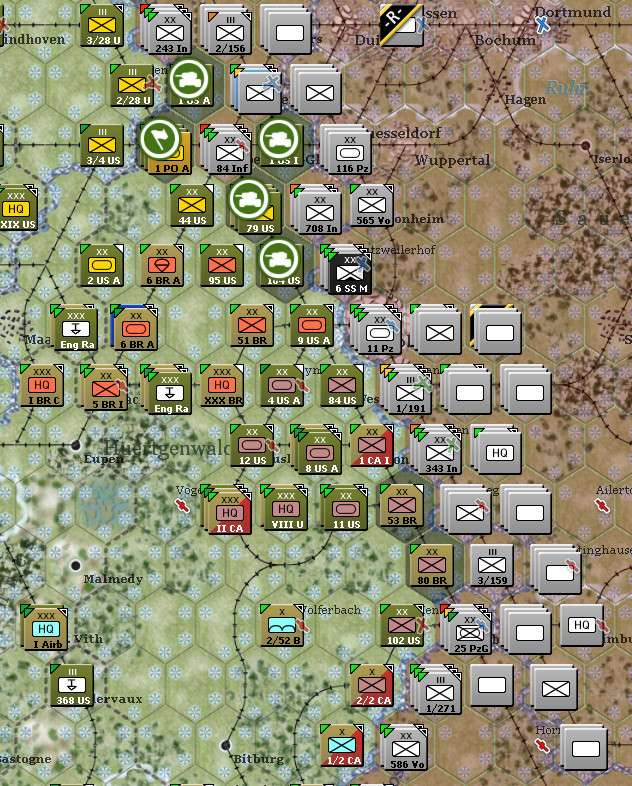
More action in Lorraine and Pfalz. Elements of the Airborne Army (this is now a mix of paras and regular formations) take Trier. To the south 1FF captures Saarbruecken.
This allows a more general offensive that ends with French tanks just outside Strasbourg and cutting the rail line south to Colmar.
South of Colmar the Germans attacked the very second rate 76 British infantry, which surprisingly managed to hold its ground.
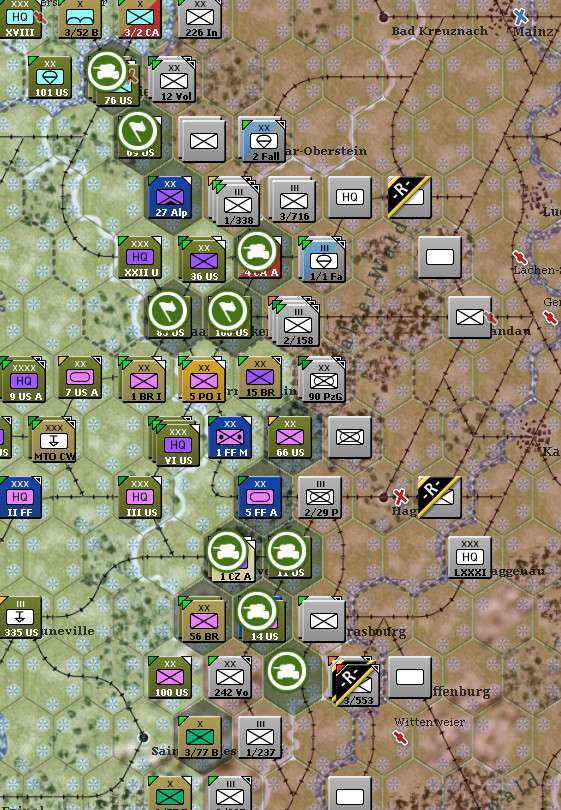
Italy – I'll avoid any discussion of what happened at Chioggia where it took me 6 attempts to clear a hex I should have taken first time. After it finally fell, managed to capture Mestre and then push my mobile elements to reach the Paratroops. They will probably be routed in the German turn but at least they are not isolated.

Looking for evidence that I may have disrupted German tank production. So in Italy a British brigade was forced back by a force including the 504 Hvy Panzer (so should have had Tigers), it is using Stug IIIs instead:
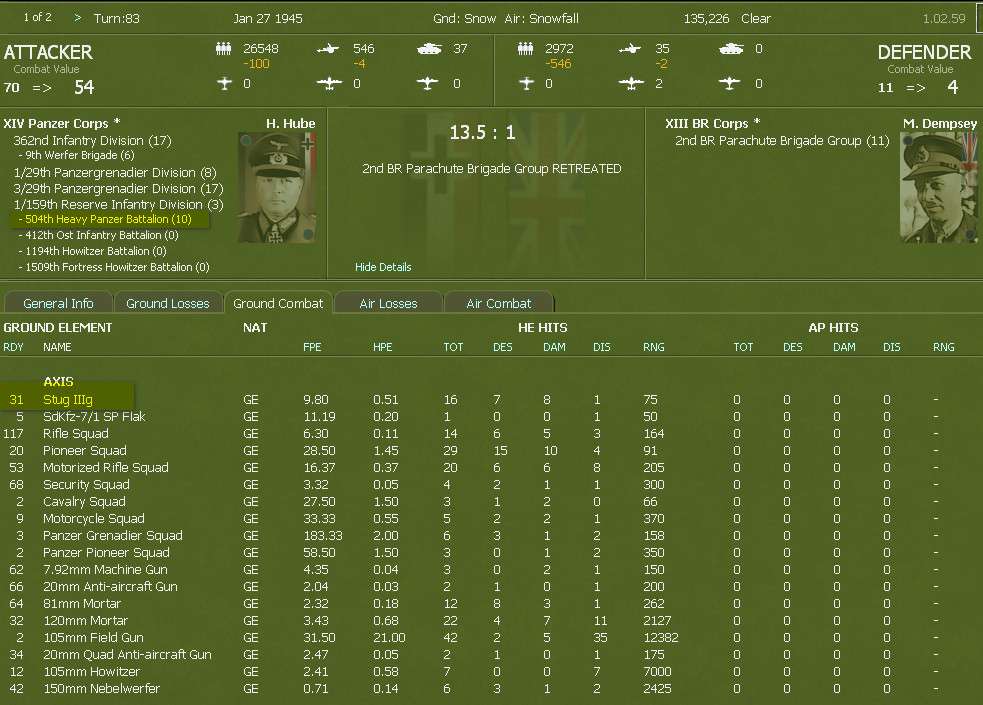
VP at + (or -) 0, ok for these turns since its basically city VP vs Loss VP.
Weather remains snowfall/snow, may flip to cold/snow next week and that means I can actually hit things with my bombers. To prepare for this, rest a lot by raising the base morale for this criteria (from my usual 52 to 60). I also suspend the few interdiction style missions I was still doing.
Of course, it does reduce the chance the Rhine will actually freeze.
So lets do things in a sort of reverse order. I Canadian is only making slow progress, movement costs are so bad that a division with 12 MP can't make a prepared attack. That plus the local Pzr division made cutting in behind Rotterdam expensive. But I'll be able to build up and am across the last barrier.

Not much action for 2 Br or 3 US as they build up.
1 Army struck north, almost surrounding Moenchen-Gladbach and reaching Krefeld. Overall, I'm happy to try and orientate this army around the north of the Ruhr, it'll also help 1 Canadian in the Netherlands.
Again, the German infantry are now as likely to rout as retreat.

More action in Lorraine and Pfalz. Elements of the Airborne Army (this is now a mix of paras and regular formations) take Trier. To the south 1FF captures Saarbruecken.
This allows a more general offensive that ends with French tanks just outside Strasbourg and cutting the rail line south to Colmar.
South of Colmar the Germans attacked the very second rate 76 British infantry, which surprisingly managed to hold its ground.

Italy – I'll avoid any discussion of what happened at Chioggia where it took me 6 attempts to clear a hex I should have taken first time. After it finally fell, managed to capture Mestre and then push my mobile elements to reach the Paratroops. They will probably be routed in the German turn but at least they are not isolated.

Looking for evidence that I may have disrupted German tank production. So in Italy a British brigade was forced back by a force including the 504 Hvy Panzer (so should have had Tigers), it is using Stug IIIs instead:

T84 - Putting the Nibelungen behind me
T84 – 3 February 1945
So as predicted weather is clear/snow, next turn is likely to be heavy rain – the worst version for me (not that I can complain) as it grounds my airpower and reduces the river ice levels. May be followed by blizzards later in the month – here's the weather chart:

VP at -2. No real sign of the v-weapons recovering but decide to put most of 8 AAF to reducing them again (just in case of a few turns of bad weather).
Set the morale to fly at 50, may as well have a big blowout. That gives me almost 16,000 aircraft to allocate. Basically every level bomber I have hits one of three hexes with this backed up by interdiction and AS. Goal is to get over the Rhine on at least one of the possible targets south of Cologne.
Seems the Germans had a similar analysis leading to massive A2A losses, roughly 280 axis planes and 200 allied lost this way. Overall possibly the heaviest losses of the war. 15 AAF's AS was particularly productive [1].

8 AAF reports a good deal of damage to the v-2 factories and some to secondary targets like the Me262 production.

So, starting in Italy, failed to take Verona but did manage Venice and place the British and S African tanks to take Friuli.

1FF takes Strasbourg, only French city still occupied is Colmar. Improving depot system gives some mobility to the Pfalz offensive able to slip some tanks fairly deep into the German lines.

And so to the set piece, spent around 30 mins adding up MP, checking who could attack, deciding to do something else, realising the weather was going to change, so I'd better do this now etc.
In effect, almost 40 pre-attack bombing missions, masses of GS and artillery produced a surprisingly easy victory.

Which then turned to panic – when I realised I'd miscounted and none of my second wave could actually cross the Rhine.
So I grabbed all my airborne units sat in the UK and they landed on the airbase. I don't think it'll hold but its one hex with no fortifications. Expecting an air assault, I stuffed it with every AA unit I had to hand.

To the north 2 British couldn't attack anywhere but did occupy more of the west bank.

Anyway, 1 US/1 Ca cheered me up. I Canadian made two gains over the Neijder Rijn and should take Rotterdam when the weather clears again. Den Haag fell after two attacks under the cover of a massive naval bombardment – that is the last v-weapon launch site captured.
Of possibly more value, 1 US managed a deep salient, cutting east of Kleve and threatening to bypass the Ruhr defences.

Losses, given the issue with the screen as presented, this combines the end T83 (ie as I sent it) and end T84 (again at the point of sending).
So permanent German losses were 44,000 men, I lost 6,000 (and a lot of tanks).
As GR reminded me, the following rule is having an effect:
In practice we are both suffering for this. Me as I have the bulk of 4 million men in contact (and in some places with poor supply), the Germans as they are now plagued by low morale, low experience formations (this is the same reason why there are now so many routs).
On the subject of missing combat capacity, I have around 7,000 damaged tanks.

So after all that, think we can manage 2 images of the week. A destroyed American glider in the snow (think this was actually from the air resupply for Bastogne).

And US troops crossing the Rhine.

By the end of the turn I have overrun 50 'factories' that would count for Strategic bombing VP. Almost worth .3 of a VP each turn. Also have 5 German city hexes so that adds another .3, lets say in combination around .55 VP per turn for my gains so far west of the Rhine.
1
You get this little pop-up if you select the show AD map mode in the ground phase. It can be quite useful for getting an overview of what worked rather than looking at every individual combat event.
So as predicted weather is clear/snow, next turn is likely to be heavy rain – the worst version for me (not that I can complain) as it grounds my airpower and reduces the river ice levels. May be followed by blizzards later in the month – here's the weather chart:

VP at -2. No real sign of the v-weapons recovering but decide to put most of 8 AAF to reducing them again (just in case of a few turns of bad weather).
Set the morale to fly at 50, may as well have a big blowout. That gives me almost 16,000 aircraft to allocate. Basically every level bomber I have hits one of three hexes with this backed up by interdiction and AS. Goal is to get over the Rhine on at least one of the possible targets south of Cologne.
Seems the Germans had a similar analysis leading to massive A2A losses, roughly 280 axis planes and 200 allied lost this way. Overall possibly the heaviest losses of the war. 15 AAF's AS was particularly productive [1].

8 AAF reports a good deal of damage to the v-2 factories and some to secondary targets like the Me262 production.

So, starting in Italy, failed to take Verona but did manage Venice and place the British and S African tanks to take Friuli.

1FF takes Strasbourg, only French city still occupied is Colmar. Improving depot system gives some mobility to the Pfalz offensive able to slip some tanks fairly deep into the German lines.

And so to the set piece, spent around 30 mins adding up MP, checking who could attack, deciding to do something else, realising the weather was going to change, so I'd better do this now etc.
In effect, almost 40 pre-attack bombing missions, masses of GS and artillery produced a surprisingly easy victory.

Which then turned to panic – when I realised I'd miscounted and none of my second wave could actually cross the Rhine.
So I grabbed all my airborne units sat in the UK and they landed on the airbase. I don't think it'll hold but its one hex with no fortifications. Expecting an air assault, I stuffed it with every AA unit I had to hand.

To the north 2 British couldn't attack anywhere but did occupy more of the west bank.

Anyway, 1 US/1 Ca cheered me up. I Canadian made two gains over the Neijder Rijn and should take Rotterdam when the weather clears again. Den Haag fell after two attacks under the cover of a massive naval bombardment – that is the last v-weapon launch site captured.
Of possibly more value, 1 US managed a deep salient, cutting east of Kleve and threatening to bypass the Ruhr defences.

Losses, given the issue with the screen as presented, this combines the end T83 (ie as I sent it) and end T84 (again at the point of sending).
So permanent German losses were 44,000 men, I lost 6,000 (and a lot of tanks).
As GR reminded me, the following rule is having an effect:
9.5.2 Frontline Attrition
"Units that begin their turn adjacent to an enemy unit in the logistics phase will suffer additional attrition losses...approximately one quarter to seven tenths of one percent of the ground elements in a unit being destroyed."
In practice we are both suffering for this. Me as I have the bulk of 4 million men in contact (and in some places with poor supply), the Germans as they are now plagued by low morale, low experience formations (this is the same reason why there are now so many routs).
On the subject of missing combat capacity, I have around 7,000 damaged tanks.

So after all that, think we can manage 2 images of the week. A destroyed American glider in the snow (think this was actually from the air resupply for Bastogne).

And US troops crossing the Rhine.

By the end of the turn I have overrun 50 'factories' that would count for Strategic bombing VP. Almost worth .3 of a VP each turn. Also have 5 German city hexes so that adds another .3, lets say in combination around .55 VP per turn for my gains so far west of the Rhine.
1
You get this little pop-up if you select the show AD map mode in the ground phase. It can be quite useful for getting an overview of what worked rather than looking at every individual combat event.
T85 - getting wet
T85 – 10 February 1945
So lets pause for dramatic effect ...
Well as forecasted, the entire front is now heavy rain and heavy mud. Next turn its meant to return to clear, unless that Siberian blizzard reaches a bit further west.

VP chart is +1, as I add more cities:

My defensive AS seems to have paid off, over the last 2 turns that is around 1,200 German planes shot down and about 700-750 lost pilots. With a bit of luck, that should keep them quiet for the rest of the game.

They attacked the key hex around 55 times (a few of those missions are my air resupply). Seems that investing in jet engined fighters can pay off.

And?
Held, in fact no attack, GR said the impact of the air defenses plus my interdiction levels made any attempt high risk with the chance I'd being able to dislocate the rest of the defensive line.
So rest the entire airforce, nothing was going to fly in any case.
Not much ground action. Tried to take Rotterdam but failed. Few skirmishers with German rearguards as 1 FF/9A press up to the Rhine.

So, here's the current OOB: I've actually managed to repair a few tanks.

Meant to add, 1 Canadian Army now has a Canadian formation under its command.

And around 12 turns to go.
My guess is at least another 4-5 turns on the Rhine (I have to expand my crossing and secure a rail bridge for resupply). I don't think I have done terminal damage to the Wehrmacht, at the very worst they have enough formations to leave a cat's cradle of units to delay me.
In truth I'm not sure where a net +61 VP will come from. That means I need to sustain a net +5 per turn, at the moment the cost of acquiring new VP is more or less being offset by my gains. Which, as I suspected a while back, puts us on the borders of a draw/allied marginal victory (with a bias towards the draw).
So lets pause for dramatic effect ...
Well as forecasted, the entire front is now heavy rain and heavy mud. Next turn its meant to return to clear, unless that Siberian blizzard reaches a bit further west.

VP chart is +1, as I add more cities:

My defensive AS seems to have paid off, over the last 2 turns that is around 1,200 German planes shot down and about 700-750 lost pilots. With a bit of luck, that should keep them quiet for the rest of the game.

They attacked the key hex around 55 times (a few of those missions are my air resupply). Seems that investing in jet engined fighters can pay off.

And?
Held, in fact no attack, GR said the impact of the air defenses plus my interdiction levels made any attempt high risk with the chance I'd being able to dislocate the rest of the defensive line.
So rest the entire airforce, nothing was going to fly in any case.
Not much ground action. Tried to take Rotterdam but failed. Few skirmishers with German rearguards as 1 FF/9A press up to the Rhine.

So, here's the current OOB: I've actually managed to repair a few tanks.

Meant to add, 1 Canadian Army now has a Canadian formation under its command.

And around 12 turns to go.
My guess is at least another 4-5 turns on the Rhine (I have to expand my crossing and secure a rail bridge for resupply). I don't think I have done terminal damage to the Wehrmacht, at the very worst they have enough formations to leave a cat's cradle of units to delay me.
In truth I'm not sure where a net +61 VP will come from. That means I need to sustain a net +5 per turn, at the moment the cost of acquiring new VP is more or less being offset by my gains. Which, as I suspected a while back, puts us on the borders of a draw/allied marginal victory (with a bias towards the draw).
T86 - The French cross the Rhine
T86 – 17 February 1945
My weather forecasters are very reliable, we revert to clear/snow. Seems it will stay the same next turn.
VP, ok I did get +7 but mainly as a reward for doing nothing. So I need +55 over 11 turns. Better capture some more cities then – and make sure the v-weapons don't return.
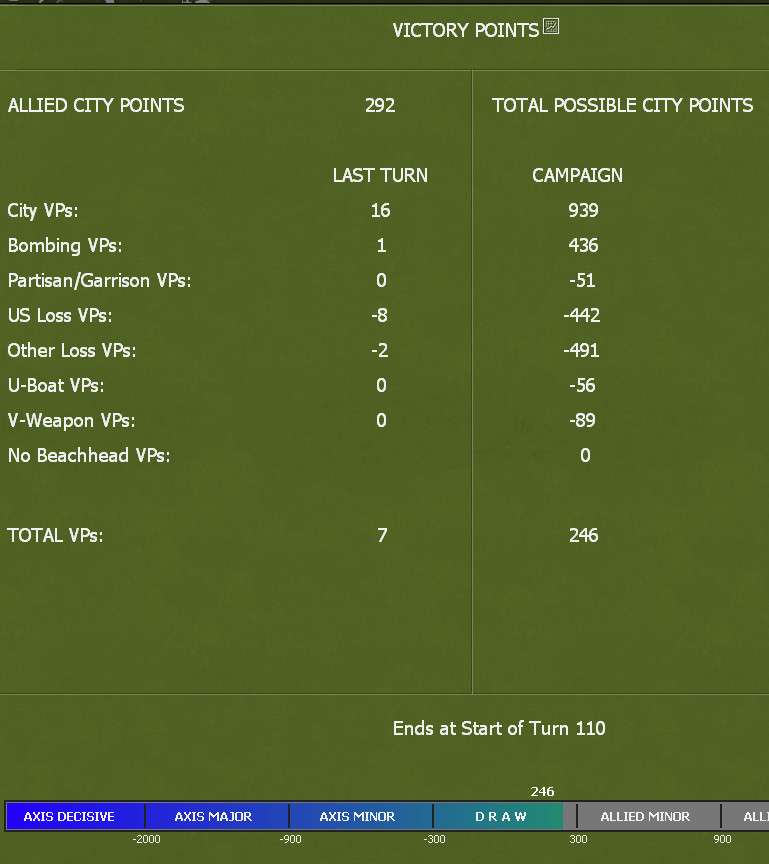
So 8 AAF does the only strategic action, v-weapons with a side trip to Berlin. Everything else is in direct support of ground operations.
Probably sensibly, the Luftwaffe stayed on the ground, even so I take heavy flak losses as its risky flying tactical air missions around the flak-heavy Ruhr.
So from north to south. 1 Canadian liberated Rotterdam and Utrecht, 1 US captured Kleve but failed to break out over the Rhine.
15A on this sector to relieve the command load on the main armies.

2 British manages to create its own bridgeheads after a couple of failed attacks. 3 US widens its grip across from Bonn.

To the south, 9 A moves up around Mainz, 1FF clears the Rhine at Strasbourg (my first rail bridge), elements of the freshly arrived 7A take Colmar and liberate all the remaining parts of France. Rhine is crossed near the Swiss border.

Finally Italy. Udine liberated, German units very low on ToE and mostly rout out of combat. Realistic goal here is the last few city VP.
Unrealistic goal is to race the Red Army for Vienna.
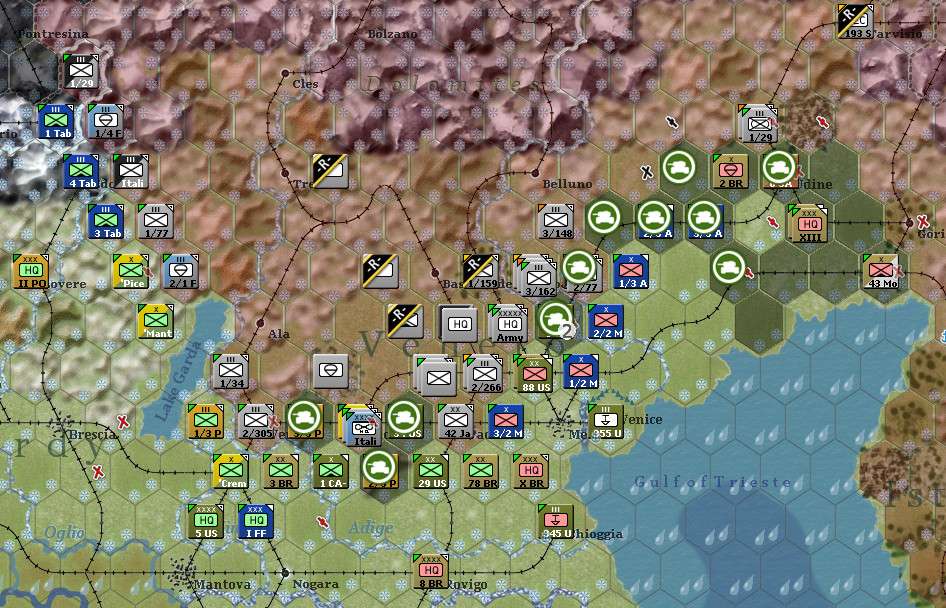
Losses – that is not going to help me achieve my desired +5 a turn.

Destroyed list – nothing of any value. GR has done a good job at stopping me encircling his better formations. Again I'm disbanding a few of the most battered units – no point waiting for them to rebuild and the elements are more use elsewhere.
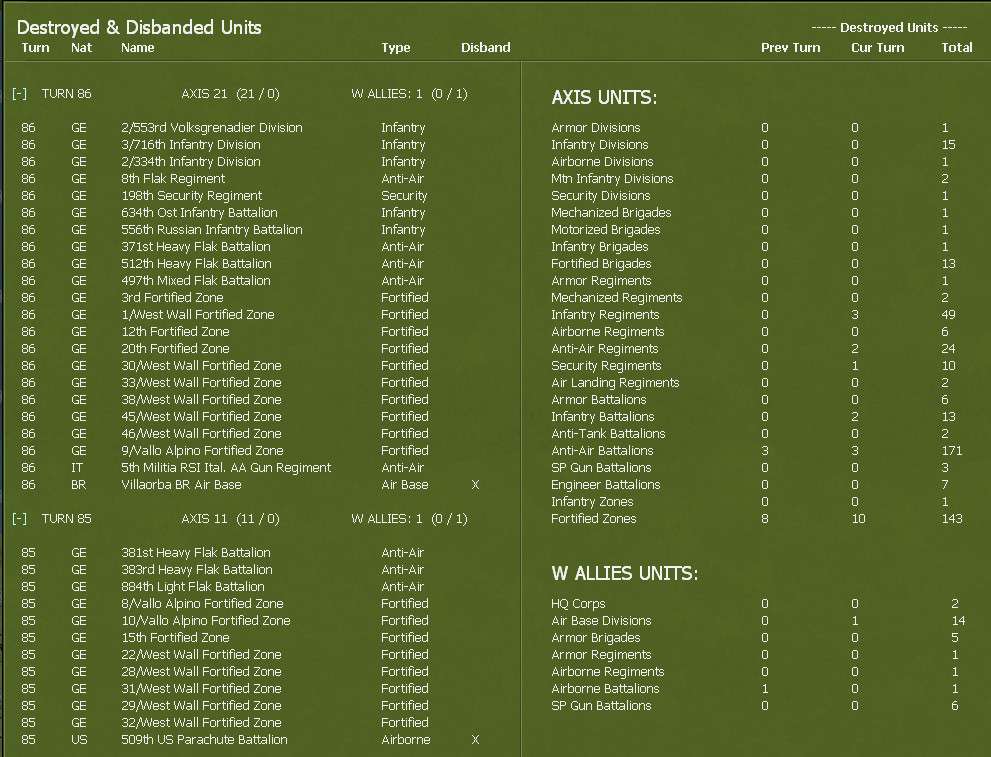
Manpower pools – sort of limping towards the end, managing most of them. Worry is the British but not too much I can do about that.

So for an image – British Buffalo amphib vehicles crossing a river

My weather forecasters are very reliable, we revert to clear/snow. Seems it will stay the same next turn.
VP, ok I did get +7 but mainly as a reward for doing nothing. So I need +55 over 11 turns. Better capture some more cities then – and make sure the v-weapons don't return.

So 8 AAF does the only strategic action, v-weapons with a side trip to Berlin. Everything else is in direct support of ground operations.
Probably sensibly, the Luftwaffe stayed on the ground, even so I take heavy flak losses as its risky flying tactical air missions around the flak-heavy Ruhr.
So from north to south. 1 Canadian liberated Rotterdam and Utrecht, 1 US captured Kleve but failed to break out over the Rhine.
15A on this sector to relieve the command load on the main armies.

2 British manages to create its own bridgeheads after a couple of failed attacks. 3 US widens its grip across from Bonn.

To the south, 9 A moves up around Mainz, 1FF clears the Rhine at Strasbourg (my first rail bridge), elements of the freshly arrived 7A take Colmar and liberate all the remaining parts of France. Rhine is crossed near the Swiss border.

Finally Italy. Udine liberated, German units very low on ToE and mostly rout out of combat. Realistic goal here is the last few city VP.
Unrealistic goal is to race the Red Army for Vienna.

Losses – that is not going to help me achieve my desired +5 a turn.

Destroyed list – nothing of any value. GR has done a good job at stopping me encircling his better formations. Again I'm disbanding a few of the most battered units – no point waiting for them to rebuild and the elements are more use elsewhere.

Manpower pools – sort of limping towards the end, managing most of them. Worry is the British but not too much I can do about that.

So for an image – British Buffalo amphib vehicles crossing a river

T87 - An interest in railway bridges
T87 – 24 February 1945
So weather is mostly cold/light snow and seems to be the same next week. This is, of course, near perfect for me. GR has been very unlucky with the weather.
Now actually it might be better if I was forced to do nothing, so I now need a net +6 per turn. Not going to happen.

Luftwaffe back to being active.
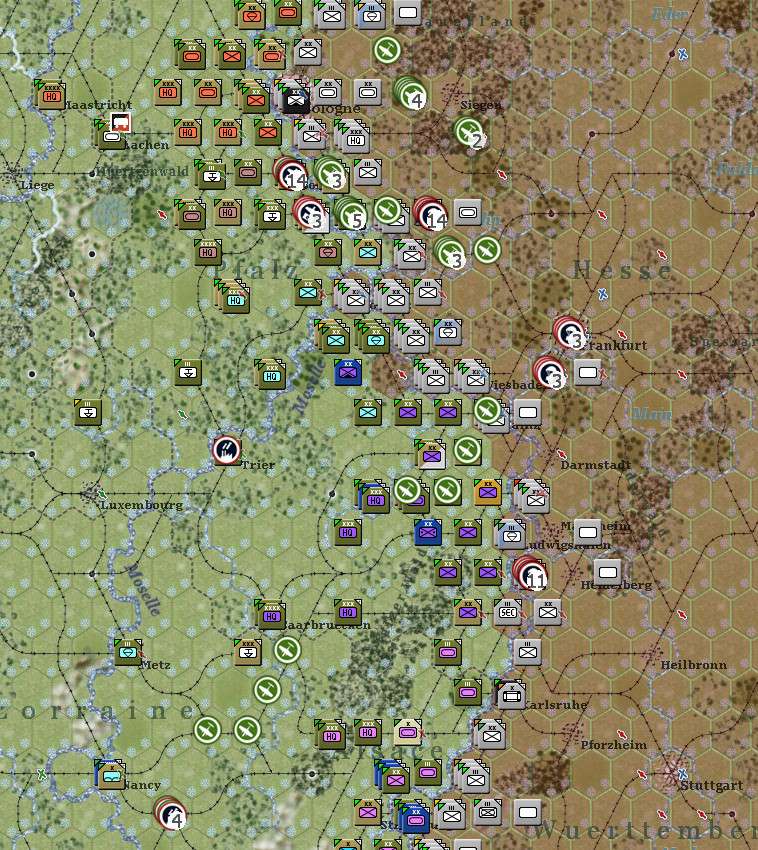
And with heavy losses among their LB assets.

My air allocation follows the usual pattern. About 50% of 8 AAF on wide ranging v-weapon sweeps, everything else bombs in support of likely ground operations.
Some interference by German fighters but not enough to create much of a problem.
So this maybe the final Italian report. I now have every VP producing hex, I'm really not going to fight across the Alps (not least the attrition will be horrible adding to my non-combat losses). Have set both depots and HQ to supply #1.
I guess I could invade Croatia (or is that blocked in WiTW?) but think that loss minimisation is of more use than a few more VP cities (given there is around 10 turns left these won't produce even .5 of a VP before the game end).
Also strip out almost all the Support Units.
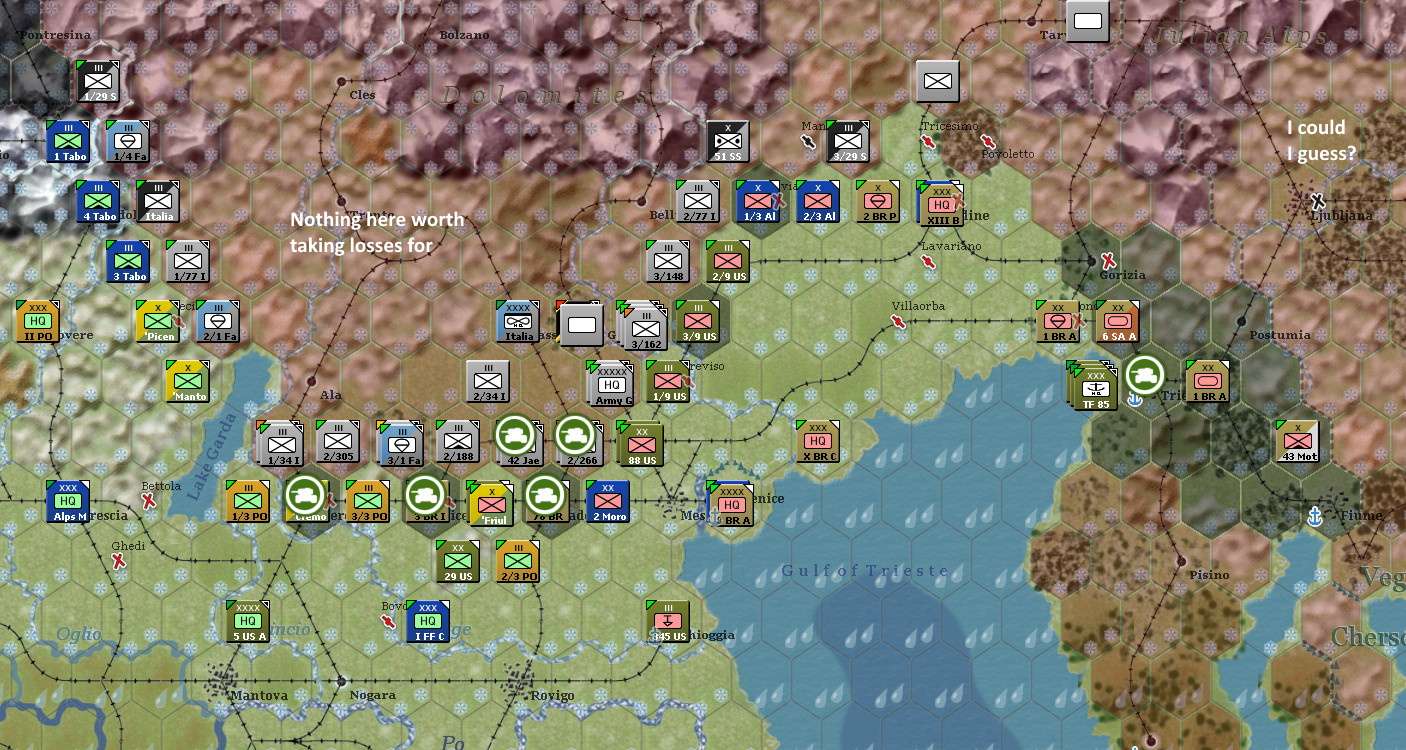
1FF and 7 Armies almost clear the lower Rhine. Frieburg and Offenburg are cities so count for VP and combined with Gaggenau count for 27 bombing points.
The reward on this sector is Ulm and Stuttgart, not only removing some v-weapon production but a lot of bombing VP.

9A and the Airborne Army clear out the west side of the Rhine, adding Koblenz, Mainz and Ludwigshafen. All the mobile units on this sector had a nice long rest.
The Mainz-Wiesbaden sector is the most desirable target due to the rail bridges.

3A and 2 Br start to set up to take Cologne. Gambled on hasty attacks to move away the screen – seems that even the once much feared Pzr Lehr is no longer such a threat.

3 Army manages to push 20 km east of the Rhine on most of its sector, 2 British much more constrained (both river hexes are in ZoC) but move east of Cologne while substantial infantry units fill in the bridgehead.
Having managed this, then attack to link up with 3 A and 5 Canadian armour encircles the city.

1 Canadian's advance in the Netherlands turns into a rout. Will divert forces to take Amsterdam, as a heavy urban hex it is 5/18 VP per turn. So it will add roughly 3 VP in total before the end of the game in itself.
Unfortunately 1 US can't really exploit due to the Germans clinging to Nijmegen. Overrun Krefeld to reduce the ZoC constraints on my movement.
Idealy 1 US and 1 Ca will swap axis of advance, all the infantry and artillery in the 1 Canadian will be best used in the Ruhr while 1 US can maybe cut loose toward Bremen.

Supply situation. In general not too bad, even the southern armies are picking up enough.

Ground losses – that is going to be lost VP, despite all the additional cities captured that turn.
I have captured around 115 strategic bombing points. So still under 1 VP per turn.
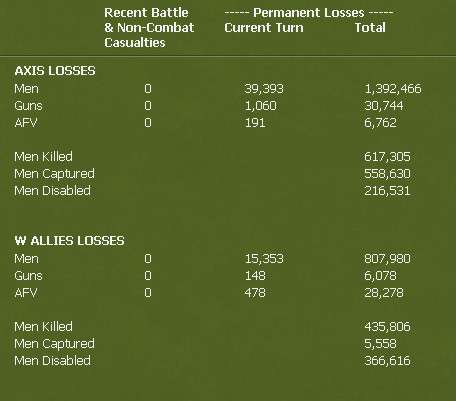
Bridges on the Rhine – my new obsession. South of this image 1 FF has the bridges at Strasbourg fully under control and will add a few more next turn.
Its on this sector there are problems. Cologne is by far the best option, its central and has a level #8 railyard so potentially becomes a very important depot.
Mainz effectively has 4 bridges and can link to the rail lines north of Cologne as well as Frankfurt. The ones around Krefeld are of little value as they go straight into the Ruhr. Its not that I don't want to take the Ruhr but that is inevitably a major operation and best started once the Ruhr is cut off from the rest of the Reich so that Essen no longer works as a NSS.

Since this is what I want, I do hope that GR has taken better care of it than in reality.

So weather is mostly cold/light snow and seems to be the same next week. This is, of course, near perfect for me. GR has been very unlucky with the weather.
Now actually it might be better if I was forced to do nothing, so I now need a net +6 per turn. Not going to happen.

Luftwaffe back to being active.

And with heavy losses among their LB assets.

My air allocation follows the usual pattern. About 50% of 8 AAF on wide ranging v-weapon sweeps, everything else bombs in support of likely ground operations.
Some interference by German fighters but not enough to create much of a problem.
So this maybe the final Italian report. I now have every VP producing hex, I'm really not going to fight across the Alps (not least the attrition will be horrible adding to my non-combat losses). Have set both depots and HQ to supply #1.
I guess I could invade Croatia (or is that blocked in WiTW?) but think that loss minimisation is of more use than a few more VP cities (given there is around 10 turns left these won't produce even .5 of a VP before the game end).
Also strip out almost all the Support Units.

1FF and 7 Armies almost clear the lower Rhine. Frieburg and Offenburg are cities so count for VP and combined with Gaggenau count for 27 bombing points.
The reward on this sector is Ulm and Stuttgart, not only removing some v-weapon production but a lot of bombing VP.

9A and the Airborne Army clear out the west side of the Rhine, adding Koblenz, Mainz and Ludwigshafen. All the mobile units on this sector had a nice long rest.
The Mainz-Wiesbaden sector is the most desirable target due to the rail bridges.

3A and 2 Br start to set up to take Cologne. Gambled on hasty attacks to move away the screen – seems that even the once much feared Pzr Lehr is no longer such a threat.

3 Army manages to push 20 km east of the Rhine on most of its sector, 2 British much more constrained (both river hexes are in ZoC) but move east of Cologne while substantial infantry units fill in the bridgehead.
Having managed this, then attack to link up with 3 A and 5 Canadian armour encircles the city.

1 Canadian's advance in the Netherlands turns into a rout. Will divert forces to take Amsterdam, as a heavy urban hex it is 5/18 VP per turn. So it will add roughly 3 VP in total before the end of the game in itself.
Unfortunately 1 US can't really exploit due to the Germans clinging to Nijmegen. Overrun Krefeld to reduce the ZoC constraints on my movement.
Idealy 1 US and 1 Ca will swap axis of advance, all the infantry and artillery in the 1 Canadian will be best used in the Ruhr while 1 US can maybe cut loose toward Bremen.

Supply situation. In general not too bad, even the southern armies are picking up enough.

Ground losses – that is going to be lost VP, despite all the additional cities captured that turn.
I have captured around 115 strategic bombing points. So still under 1 VP per turn.

Bridges on the Rhine – my new obsession. South of this image 1 FF has the bridges at Strasbourg fully under control and will add a few more next turn.
Its on this sector there are problems. Cologne is by far the best option, its central and has a level #8 railyard so potentially becomes a very important depot.
Mainz effectively has 4 bridges and can link to the rail lines north of Cologne as well as Frankfurt. The ones around Krefeld are of little value as they go straight into the Ruhr. Its not that I don't want to take the Ruhr but that is inevitably a major operation and best started once the Ruhr is cut off from the rest of the Reich so that Essen no longer works as a NSS.

Since this is what I want, I do hope that GR has taken better care of it than in reality.

- Joel Billings
- Posts: 33526
- Joined: Wed Sep 20, 2000 8:00 am
- Location: Santa Rosa, CA
- Contact:
RE: T87 - An interest in railway bridges
Great AAR! BTW, if you were using the Optional City VP rules, you would have 600 less VPs at this moment, but could gain the following VPs:
Essen 200
Amsterdam 100
Cologne 100
Stuttgart 100
Munich 100
Nuremberg 100
Hannover 100
Hamburg 100
Leipzig 100
This would mean at this point the score would be in the German Marginal range (but not for long). It would also give you another path to a Marginal Victory if you could gain a lot more points from this list.
Essen 200
Amsterdam 100
Cologne 100
Stuttgart 100
Munich 100
Nuremberg 100
Hannover 100
Hamburg 100
Leipzig 100
This would mean at this point the score would be in the German Marginal range (but not for long). It would also give you another path to a Marginal Victory if you could gain a lot more points from this list.
ORIGINAL: loki100
T87 – 24 February 1945
So weather is mostly cold/light snow and seems to be the same next week. This is, of course, near perfect for me. GR has been very unlucky with the weather.
Now actually it might be better if I was forced to do nothing, so I now need a net +6 per turn. Not going to happen.
All understanding comes after the fact.
-- Soren Kierkegaard
-- Soren Kierkegaard
RE: T87 - An interest in railway bridges
ORIGINAL: Joel Billings
Great AAR! BTW, if you were using the Optional City VP rules, you would have 600 less VPs at this moment, but could gain the following VPs:
Essen 200
Amsterdam 100
Cologne 100
Stuttgart 100
Munich 100
Nuremberg 100
Hannover 100
Hamburg 100
Leipzig 100
This would mean at this point the score would be in the German Marginal range (but not for long). It would also give you another path to a Marginal Victory if you could gain a lot more points from this list.
...
we did discuss using them but decided to stick to the classic VP set. Given where we are, I've just taken Amsterdam and Cologne (T88), I'm pretty sure of Stuttgart, probably Essen not sure beyond that (the forecast for T89 is heavy rain).
GR is doing a good job on the end phase, he's not really trying to hold where I am now over the Rhine but laying down a cat's cradle of units, some I can clear with hasty attacks but even so combat delays and ZoC (plus MP shortages till I get some depots east of the Rhine) are slowing me down.
I suspect either way we'd be roughly in the same area, ie a draw in the range +200-250.
This could change as I doubt he is able to rescue many of the routed units. Last turn I saw a couple of 7,000 men divisions take 5,000 losses on retreat/rout. Given the NM and likely ToE/Exp they are never going to recover. I also think an SS Pzr division just evaporated under sustained bombing.
So I might get a bit of a chance to run riot in the last few turns (but I really doubt it).



